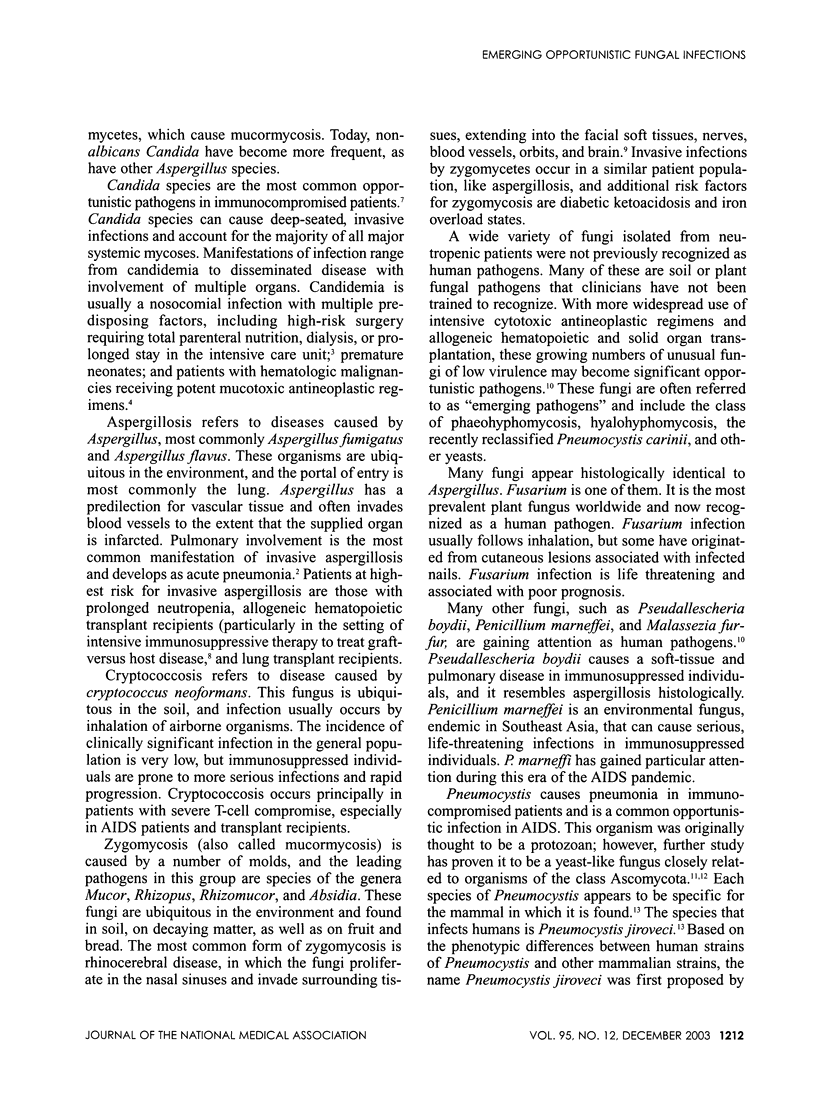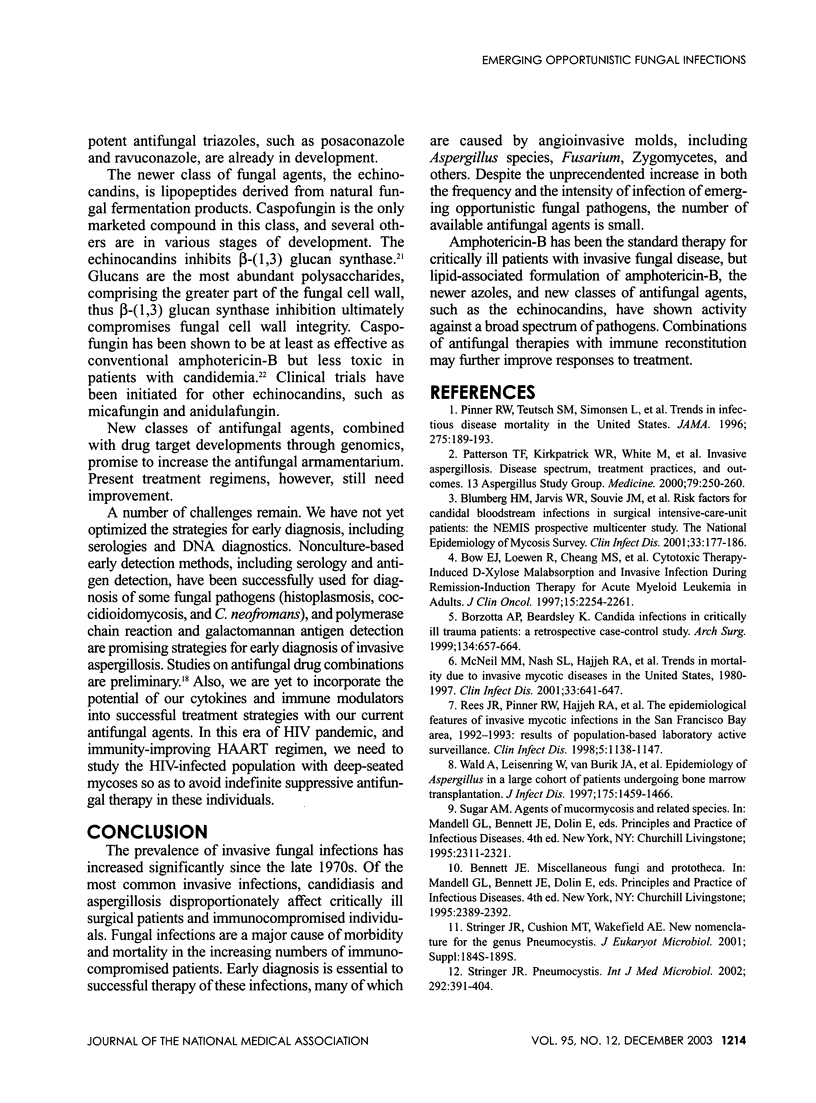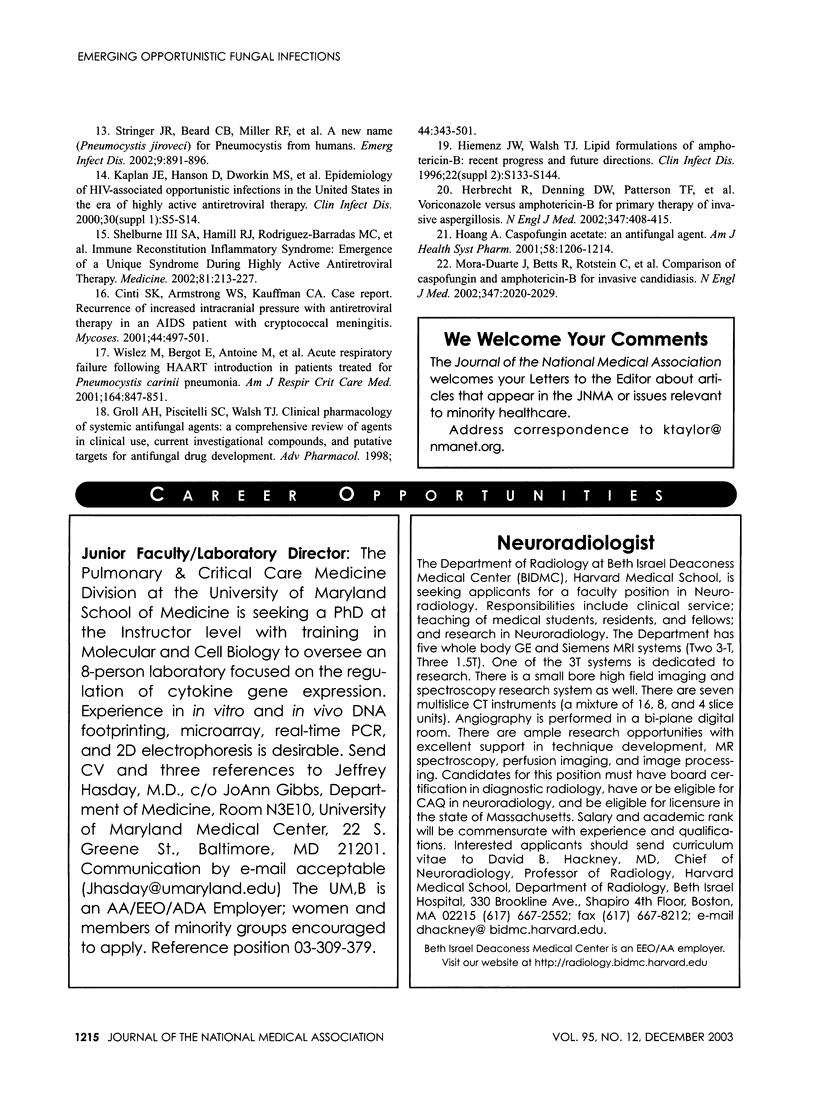Abstract
Medical mycology involves the study of pathogenic fungi and their identification in the laboratory. Mycology has developed into a field that demands the attention of all clinicians treating patients in hospitals. Interest in medical mycology has grown in recent years due to a dramatic rise in the rates of fungal infections. An overview of well-known medically significant opportunistic fungi, such as Candida, Cryptococcus, Aspergillus and Zygomycetes, as well as emerging fungal pathogens, are discussed. Antifungal failures in these individuals are high; consequently, mortality rates are also high, despite standard therapy with amphotericin-B, lipid-associated formulation of amphotericin-B and the azoles. This underscores the need for new approaches and therapies to improve outcomes in high-risk individuals.
Full text
PDF




Selected References
These references are in PubMed. This may not be the complete list of references from this article.
- Blumberg H. M., Jarvis W. R., Soucie J. M., Edwards J. E., Patterson J. E., Pfaller M. A., Rangel-Frausto M. S., Rinaldi M. G., Saiman L., Wiblin R. T. Risk factors for candidal bloodstream infections in surgical intensive care unit patients: the NEMIS prospective multicenter study. The National Epidemiology of Mycosis Survey. Clin Infect Dis. 2001 Jun 20;33(2):177–186. doi: 10.1086/321811. [DOI] [PubMed] [Google Scholar]
- Borzotta A. P., Beardsley K. Candida infections in critically ill trauma patients: a retrospective case-control study. Arch Surg. 1999 Jun;134(6):657–665. doi: 10.1001/archsurg.134.6.657. [DOI] [PubMed] [Google Scholar]
- Bow E. J., Loewen R., Cheang M. S., Shore T. B., Rubinger M., Schacter B. Cytotoxic therapy-induced D-xylose malabsorption and invasive infection during remission-induction therapy for acute myeloid leukemia in adults. J Clin Oncol. 1997 Jun;15(6):2254–2261. doi: 10.1200/JCO.1997.15.6.2254. [DOI] [PubMed] [Google Scholar]
- Cinti S. K., Armstrong W. S., Kauffman C. A. Case report. Recurrence of increased intracranial pressure with antiretroviral therapy in an AIDS patient with cryptococcal meningitis. Mycoses. 2001 Dec;44(11-12):497–501. doi: 10.1046/j.1439-0507.2001.00663.x. [DOI] [PubMed] [Google Scholar]
- Groll A. H., Piscitelli S. C., Walsh T. J. Clinical pharmacology of systemic antifungal agents: a comprehensive review of agents in clinical use, current investigational compounds, and putative targets for antifungal drug development. Adv Pharmacol. 1998;44:343–500. doi: 10.1016/s1054-3589(08)60129-5. [DOI] [PubMed] [Google Scholar]
- Herbrecht Raoul, Denning David W., Patterson Thomas F., Bennett John E., Greene Reginald E., Oestmann Jörg-W, Kern Winfried V., Marr Kieren A., Ribaud Patricia, Lortholary Olivier. Voriconazole versus amphotericin B for primary therapy of invasive aspergillosis. N Engl J Med. 2002 Aug 8;347(6):408–415. doi: 10.1056/NEJMoa020191. [DOI] [PubMed] [Google Scholar]
- Hiemenz J. W., Walsh T. J. Lipid formulations of amphotericin B: recent progress and future directions. Clin Infect Dis. 1996 May;22 (Suppl 2):S133–S144. doi: 10.1093/clinids/22.supplement_2.s133. [DOI] [PubMed] [Google Scholar]
- Hoang A. Caspofungin acetate: an antifungal agent. Am J Health Syst Pharm. 2001 Jul 1;58(13):1206–1217. doi: 10.1093/ajhp/58.13.1206. [DOI] [PubMed] [Google Scholar]
- Kaplan J. E., Hanson D., Dworkin M. S., Frederick T., Bertolli J., Lindegren M. L., Holmberg S., Jones J. L. Epidemiology of human immunodeficiency virus-associated opportunistic infections in the United States in the era of highly active antiretroviral therapy. Clin Infect Dis. 2000 Apr;30 (Suppl 1):S5–14. doi: 10.1086/313843. [DOI] [PubMed] [Google Scholar]
- McNeil M. M., Nash S. L., Hajjeh R. A., Phelan M. A., Conn L. A., Plikaytis B. D., Warnock D. W. Trends in mortality due to invasive mycotic diseases in the United States, 1980-1997. Clin Infect Dis. 2001 Jul 30;33(5):641–647. doi: 10.1086/322606. [DOI] [PubMed] [Google Scholar]
- Mora-Duarte Jorge, Betts Robert, Rotstein Coleman, Colombo Arnaldo Lopes, Thompson-Moya Luis, Smietana Juanita, Lupinacci Robert, Sable Carole, Kartsonis Nicholas, Perfect John. Comparison of caspofungin and amphotericin B for invasive candidiasis. N Engl J Med. 2002 Dec 19;347(25):2020–2029. doi: 10.1056/NEJMoa021585. [DOI] [PubMed] [Google Scholar]
- Patterson T. F., Kirkpatrick W. R., White M., Hiemenz J. W., Wingard J. R., Dupont B., Rinaldi M. G., Stevens D. A., Graybill J. R. Invasive aspergillosis. Disease spectrum, treatment practices, and outcomes. I3 Aspergillus Study Group. Medicine (Baltimore) 2000 Jul;79(4):250–260. doi: 10.1097/00005792-200007000-00006. [DOI] [PubMed] [Google Scholar]
- Pinner R. W., Teutsch S. M., Simonsen L., Klug L. A., Graber J. M., Clarke M. J., Berkelman R. L. Trends in infectious diseases mortality in the United States. JAMA. 1996 Jan 17;275(3):189–193. [PubMed] [Google Scholar]
- Rees J. R., Pinner R. W., Hajjeh R. A., Brandt M. E., Reingold A. L. The epidemiological features of invasive mycotic infections in the San Francisco Bay area, 1992-1993: results of population-based laboratory active surveillance. Clin Infect Dis. 1998 Nov;27(5):1138–1147. [PubMed] [Google Scholar]
- Shelburne Samuel A., 3rd, Hamill Richard J., Rodriguez-Barradas Maria C., Greenberg Stephen B., Atmar Robert L., Musher Daniel W., Gathe Joseph C., Jr, Visnegarwala Fehmida, Trautner Barbara W. Immune reconstitution inflammatory syndrome: emergence of a unique syndrome during highly active antiretroviral therapy. Medicine (Baltimore) 2002 May;81(3):213–227. doi: 10.1097/00005792-200205000-00005. [DOI] [PubMed] [Google Scholar]
- Stringer J. R., Cushion M. T., Wakefield A. E. New nomenclature for the genus Pneumocystis. J Eukaryot Microbiol. 2001;Suppl:184S–189S. doi: 10.1111/j.1550-7408.2001.tb00512.x. [DOI] [PubMed] [Google Scholar]
- Stringer James R., Beard Charles B., Miller Robert F., Wakefield Ann E. A new name (Pneumocystis jiroveci) for Pneumocystis from humans. Emerg Infect Dis. 2002 Sep;8(9):891–896. doi: 10.3201/eid0809.020096. [DOI] [PMC free article] [PubMed] [Google Scholar]
- Stringer James R. Pneumocystis. Int J Med Microbiol. 2002 Oct;292(5-6):391–404. doi: 10.1078/1438-4221-00222. [DOI] [PubMed] [Google Scholar]
- Wald A., Leisenring W., van Burik J. A., Bowden R. A. Epidemiology of Aspergillus infections in a large cohort of patients undergoing bone marrow transplantation. J Infect Dis. 1997 Jun;175(6):1459–1466. doi: 10.1086/516480. [DOI] [PubMed] [Google Scholar]
- Wislez M., Bergot E., Antoine M., Parrot A., Carette M. F., Mayaud C., Cadranel J. Acute respiratory failure following HAART introduction in patients treated for Pneumocystis carinii pneumonia. Am J Respir Crit Care Med. 2001 Sep 1;164(5):847–851. doi: 10.1164/ajrccm.164.5.2007034. [DOI] [PubMed] [Google Scholar]


